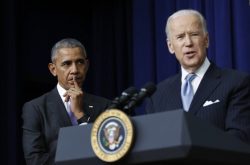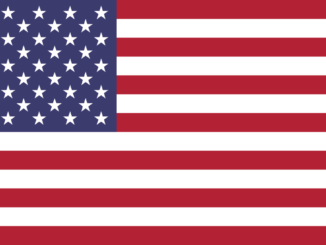 During his April 28 speech to Congress, President Biden asserted that white supremacism is currently the most lethal terrorist threat to the country, implicitly downplaying the threat posed by Islamist terror. The Biden administration has yet to clarify its attitude toward Islamism, or radical Islam, but early signs suggest it will downplay the problem just as did the Obama administration, in which Biden served as vice president.
During his April 28 speech to Congress, President Biden asserted that white supremacism is currently the most lethal terrorist threat to the country, implicitly downplaying the threat posed by Islamist terror. The Biden administration has yet to clarify its attitude toward Islamism, or radical Islam, but early signs suggest it will downplay the problem just as did the Obama administration, in which Biden served as vice president.
The last Democratic administration refocused attention away from Islamism toward white supremacy. It changed the nomenclature from terrorism to “man-caused disasters”; obfuscated Islamism as a motivating ideology to the extent of insisting that Nidal Hasan’s 2009 Islamist assault on Fort Hood and Alton Nolen’s 2014 beheading of a co-worker were motivated by “workplace violence”; impeded a congressional probe into the Fort Hood attack; and issued a report assessing that domestic right-wing extremists in the military and elsewhere posed an implicit threat of danger, although the report claimed “no specific information that domestic rightwing terrorists are currently planning acts of violence.”
By itself, the prior administration’s efforts to focus on the danger posed by other types of extremism weren’t necessarily wrong, even though it had no information about immediate threats of violence, because violent ideologies can and have propelled adherents to violent action. Keeping an eye on extremists (within constitutional and other legal boundaries) can help law enforcement prevent acts of violence.
That is why the Obama administration’s turning a blind eye to Islamist ideology was so perplexing. Heeding complaints from Islamist sympathizers, it purged FBI training and other materials of information warning about the ideology, on the grounds that they were “offensive.” According to Judicial Watch, “the excised material included references linking the Muslim Brotherhood to terrorism, [and] tying al Qaeda to the 1993 World Trade Center and Khobar Towers bombings.”
Its FBI issued public affairs guidance explaining that it had developed “guiding principles” with the help of “experts outside of the FBI” — unidentified, but presumably the same Islamist organizations that had lobbied for the purge — and would continue to do so in developing future training materials. Notably, the guidance was issued on December 13, 2011, ten months after Senators Joseph Lieberman and Susan Collins issued a report recommending focus on ideological radicalization to identify and prevent potential threats by extremists like the Fort Hood shooter.
Also under the prior administration, the Department of Justice (DOJ) issued guidance memos on November 16, 2010, and January 6, 2012, stressing the importance of engaging the Muslim American community, identifying Muslim Americans as victims of hate crimes, and promoting special outreach to them to build trust and prevent their feeling “discomfort about their relationship with the government.”
(The guidance documents were produced in 2020 in response to a 2014 Freedom of Information Act request to the self-described “most transparent administration in history.”)
There are signs the current administration will follow a similar path. The new president hasn’t clearly articulated policies toward Islamism, but his decisions to rescind the Trump travel ban, pull U.S. combat troops out of Afghanistan — by 9/11, no less — and re-engage with Iran suggest he will likewise downplay the threat of violence from this ideological wellspring. The Department of Homeland Security (DHS) is revamping its Countering Violent Extremism (CVE) grants away from a focus on Islamism toward more focus on domestic extremism. This is consistent with the new administration’s campaign positions, which identified Muslims solely as victims of discrimination and hate crimes, and ignored the issue of Islamism as an ideology promoting and inspiring violence.
The new administration has also ordered the military to “stand down” to address extremism within its ranks; issued a terrorism advisory, without evidence of a specific plot, about “extremists with objections to … the presidential transition”; made and then walked back claims that unarmed Capitol rioters intended “to capture and assassinate elected officials”; and asked courts to deny bail to those arrested for participating in the Capitol Hill riot.
The proposed Domestic Terrorism Prevention Act of 2021 takes pains to exclude Islamists, although it’s unclear whether the Biden administration supports it. Among other things, the proposed bill would require DHS, DOJ, and the FBI to provide training in “understanding, detecting, deterring, and investigating acts of domestic terrorism and White supremacist and neo-Nazi infiltration of law enforcement and corrections agencies.” The proposed training is noteworthy, not just because the training explicitly targets white supremacist and neo-Nazi ideologies while excluding Islamism, and not just because a January 19 DOJ memo expressed concerns about requiring the FBI to share its training with Congress, but because in excluding Islamist ideology, it conforms to the last Democratic administration’s December 13, 2011, FBI guidance, discussed above.
It’s worth noting that perpetrators of racial violence are increasingly inspired by violence overseas, as in New Zealand and Norway, and increasingly train overseas, so attempts to characterize white supremacism as solely “domestic” while classifying Islamist extremism as solely “foreign” seem misguided, at best. It should also be noted that while FBI director Christopher Wray has testified that white supremacism is the biggest chunk of racially motivated terrorism, which is the biggest chunk of domestic terrorism, the FBI classifies Islamist terrorism separately from domestic terrorism.
Rather than focusing on malevolent ideologies to nip potential violence in the bud, the Obama administration all but ignored Islamism as an ideology and specifically sought friendly engagement with the Muslim community while disregarding warning signs of ideologically motivated violence, and simultaneously seeking to confront white supremacist and anti-government ideologies in the absence of concrete threats of violence. The new administration shows signals that it will follow the same path, although it’s too soon to tell for sure.



